Input interpretation

di-sec-octyl phthalate
Chemical names and formulas
![formula | C_6H_4[CO_2CH_2CH(C_2H_5)(CH_2)_3CH_3]_2 Hill formula | C_24H_38O_4 name | di-sec-octyl phthalate IUPAC name | benzene-1, 2-dicarboxylic acid bis(2-ethylhexyl) ester alternate names | benzene-1, 2-dicarboxylic acid bis(2-ethylhexyl)ester | bis(2-ethylhexyl)benzene-1, 2-dicarboxylate | bis(2-ethylhexyl)phthalate | dioctylphthalate | DOP | phthalic acid bis(2-ethylhexyl ester) mass fractions | C (carbon) 73.8% | H (hydrogen) 9.81% | O (oxygen) 16.4%](../image_source/a524d1886a228c63f5be7d2daa4a8bcd.png)
formula | C_6H_4[CO_2CH_2CH(C_2H_5)(CH_2)_3CH_3]_2 Hill formula | C_24H_38O_4 name | di-sec-octyl phthalate IUPAC name | benzene-1, 2-dicarboxylic acid bis(2-ethylhexyl) ester alternate names | benzene-1, 2-dicarboxylic acid bis(2-ethylhexyl)ester | bis(2-ethylhexyl)benzene-1, 2-dicarboxylate | bis(2-ethylhexyl)phthalate | dioctylphthalate | DOP | phthalic acid bis(2-ethylhexyl ester) mass fractions | C (carbon) 73.8% | H (hydrogen) 9.81% | O (oxygen) 16.4%
Lewis structure

Draw the Lewis structure of di-sec-octyl phthalate. Start by drawing the overall structure of the molecule, ignoring potential double and triple bonds: Count the total valence electrons of the carbon (n_C, val = 4), hydrogen (n_H, val = 1), and oxygen (n_O, val = 6) atoms: 24 n_C, val + 38 n_H, val + 4 n_O, val = 158 Calculate the number of electrons needed to completely fill the valence shells for carbon (n_C, full = 8), hydrogen (n_H, full = 2), and oxygen (n_O, full = 8): 24 n_C, full + 38 n_H, full + 4 n_O, full = 300 Subtracting these two numbers shows that 300 - 158 = 142 bonding electrons are needed. Each bond has two electrons, so in addition to the 66 bonds already present in the diagram add 5 bonds. To minimize formal charge oxygen wants 2 bonds and carbon wants 4 bonds. Identify the atoms that want additional bonds and the number of electrons remaining on each atom: Fill in the 5 bonds by pairing electrons between adjacent highlighted atoms. Note that the six atom ring is aromatic, so that the single and double bonds may be rearranged: Answer: | |
3D structure
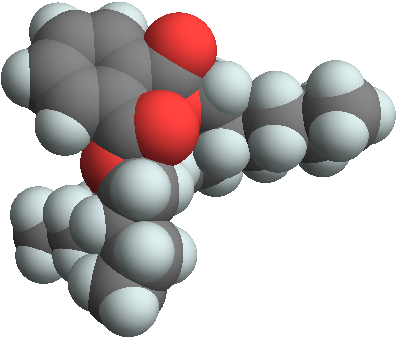
3D structure
Basic properties
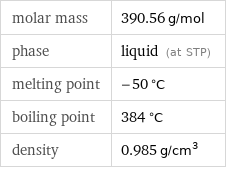
molar mass | 390.56 g/mol phase | liquid (at STP) melting point | -50 °C boiling point | 384 °C density | 0.985 g/cm^3
Units

Liquid properties (at STP)
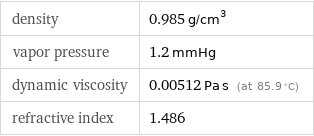
density | 0.985 g/cm^3 vapor pressure | 1.2 mmHg dynamic viscosity | 0.00512 Pa s (at 85.9 °C) refractive index | 1.486
Units

Thermodynamic properties
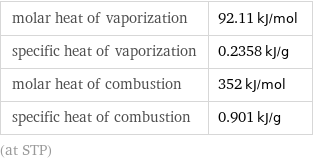
molar heat of vaporization | 92.11 kJ/mol specific heat of vaporization | 0.2358 kJ/g molar heat of combustion | 352 kJ/mol specific heat of combustion | 0.901 kJ/g (at STP)
Chemical identifiers

CAS number | 117-81-7 Beilstein number | 1890696 PubChem CID number | 8343 PubChem SID number | 24874474 SMILES identifier | CCCCC(CC)COC(=O)C1=CC=CC=C1C(=O)OCC(CC)CCCC InChI identifier | InChI=1/C24H38O4/c1-5-9-13-19(7-3)17-27-23(25)21-15-11-12-16-22(21)24(26)28-18-20(8-4)14-10-6-2/h11-12, 15-16, 19-20H, 5-10, 13-14, 17-18H2, 1-4H3 RTECS number | TI0350000 MDL number | MFCD00009493
NFPA label

NFPA label

NFPA health rating | 0 NFPA fire rating | 1 NFPA reactivity rating | 0
Safety properties
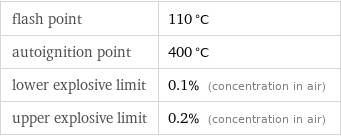
flash point | 110 °C autoignition point | 400 °C lower explosive limit | 0.1% (concentration in air) upper explosive limit | 0.2% (concentration in air)
Toxicity properties

odor | odorless threshold limit value | 0.3 ppmv

RTECS classes | agricultural chemical and pesticide | tumorigen | mutagen | reproductive effector | human data | primary irritant